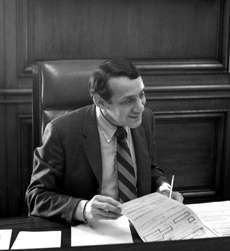LGBT culture in San Francisco
| Part of a series on |
| Lesbian, gay, bisexual, and transgender (LGBT) people |
|---|
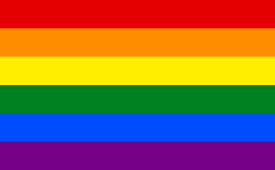 |
|
|
The lesbian, gay, bisexual and transgender (LGBT) community in San Francisco is one of the largest and most prominent LGBT communities in the world, and is one of the most important in the history of LGBT rights and activism. The city itself has, among its many nicknames, the nickname "gay capital of the world", and has been described as "the original 'gay-friendly city'".[1] LGBT culture is also active within companies that are based in Silicon Valley, which is located within the southern San Francisco Bay Area.[2]
History
19th century
San Francisco's LGBT culture has it roots in the city's own origin as a frontier-town, what SF State University professor Alamilla Boyd characterizes as “San Francisco’s history of sexual permissiveness and its function as a wide-open town - a town where anything goes".[3] The discovery of gold saw a boom in population from 800 to 35,000 residents between 1848 and 1850. These immigrants were composed of miners and fortune seekers from a variety of nationalities and cultures, although over 95% were young men.[4]
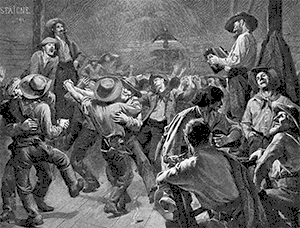
These transient and diverse populations thrust into a relatively anarchic environment were less likely to conform to social conventions. For example, with an unbalanced gender ratio, men often assumed roles conventionally assigned to women in social and domestic settings. Cross-gender dress and same-sex dancing were prevalent at city masquerade balls where some men would assume the traditional role of women going so far as to wear female attire.[4] In her study “Arresting dress, cross-dressing in nineteenth century San Francisco”, Clare Sears also describes numerous cases of women who donned men’s clothing in public spaces for increased social and economic freedom, safety, and gender progressive experimentation. Cross-dressing is still an important part of LGBT culture in the city today.
The late 1800s saw a shift in the demographics of the city along with new social and political attitudes. Anti-vice campaigns emerged to target prostitution along with the criminalization of perceived gender transgressions including outlawing cross-dressing in 1863.[4] Cross-dressing laws and public decency laws continued to inform LGBT culture and its interactions with law enforcement well into the 20th century. This political shift resulted in San Francisco’s queer culture remerging in bars, nightclubs, and entertainment of the Barbary Coast, removed from policing and control.[3] Through the 1890s to 1907, the Barbary Coast, San Francisco’s early red-light district located on Pacific Avenue, featured same-sex prostitution and female impersonators who served male clientele.[3][5]
20th century
Through WWII - in the shadows

Michael Stabile of Out stated that the first "notorious" gay bar in San Francisco was The Dash, which opened in 1908.[6] During World War I, the U.S. Navy began the "blue discharge" practice, which discharged known homosexuals in port cities, helping to create a gay community in San Francisco.[7] The San Francisco LGBT community first fully formed in the 1920s and 1930s.[8] The most prominent LGBT area then was North Beach.[8] Mona's, San Francisco's first lesbian bar, opened on Union Street in 1934, and featured cross-dressing waitresses as well as entertainer Gladys Bentley.[9] Nightclubs with drag shows drew both gay and straight audiences.[10]
During World War II, gay night life in San Francisco went through several waves of crackdown and reorganization. From 1942 to 1943, the San Francisco Moral Drive—consisting of military patrols—carried out a series of raids targeting the gay bars in San Francisco, with the stated aim of protecting servicemen from homosexuals. Chinatown, as one of places where gay visitors gathered, had also been searched several times. For example, In 1943, the police raided the gay bar, Rickshaw in Chinatown, and arrested 24 patrons and two dozen customers, including a couple of lesbians who tried to fight back and triggered a small riot.[11]
Todd J. Ormsbee, an American studies professor at San Jose State University who wrote The Meaning of Gay: Interaction, Publicity, and Community among Homosexual Men in 1960s San Francisco, stated that a "somewhat more open gay male culture" appeared in San Francisco due to the city's "relative safety" compared to other American cities and due to a "permissiveness" in the city's culture.[12]
1950s - the Beats, and first organizations
Beat culture erupted in San Francisco in the 1950s with a rebellion against middle class values and thus became aligned with homosexuality and other lifestyles not part of mainstream culture. The beat poets who relocated to San Francisco from New York flourished in San Francisco's permissive atmosphere, and some like Allen Ginsberg were openly gay. In these conditions the first homosexual groups were founded, such as the Daughters of Bilitis, founded in San Francisco, and the Mattachine Society, which started in Los Angeles.[13] Police raids on The Black Cat bar, which had a bohemian and LGBT clientele and featured entertainer and activist Jose Sarria, sparked an important legal fight for homosexual protections in the 1950s.[14][15]
1960s - SF as gay capital, first struggles for recognition
The Tavern Guild, the first gay business association in the United States, was created by gay bar owners in 1962 as a response to continued police harassment and closing of gay bars (including the Tay-Bush Inn raid), and continued until 1995.[16]
San Francisco became linked with the LGBT community in the media as a result of a June 1964 Life article, "Gay San Francisco," which stated that San Francisco was the "gay capital of America."[17]
The Society for Individual Rights (SIR), founded in San Francisco in 1964, published the magazine Vector and became within two years the largest homophile organization in the United States. SIR focused on community building, public identity and legal and social services.[18] It challenged the prevailing idea that homosexuality should be kept secret when it hosted a public dance of 600 people at California Hall on Polk Street, attracting police harassment as well as support from local religious leaders.[19]
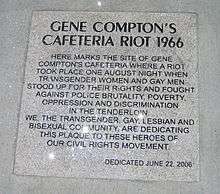
Vanguard, an organization of LGBT youth in the low-income Tenderloin district, was created in 1965. It was considered the first Gay Liberation organization in the U.S.[20][21]
In 1966, one of the first recorded transgender riots in US history took place. The Compton's Cafeteria Riot occurred in the Tenderloin district of San Francisco. The night after the riot, more transgender people, hustlers, Tenderloin street people, and other members of the LGBT community joined in a picket of the cafeteria, which would not allow transgender people back in. The demonstration ended with the newly installed plate-glass windows being smashed again. According to the online encyclopedia glbtq.com, "In the aftermath of the riot at Compton's, a network of transgender social, psychological, and medical support services was established, which culminated in 1968 with the creation of the National Transsexual Counseling Unit [NTCU], the first such peer-run support and advocacy organization in the world".[22]
One of the earliest organizations for bisexuals, the Sexual Freedom League in San Francisco, was facilitated by Margo Rila and Frank Esposito beginning in 1967.[23] Two years later, during a staff meeting at a San Francisco mental health facility serving LGBT people, nurse Maggi Rubenstein came out as bisexual. Due to this, bisexuals began to be included in the facility's programs for the first time.[23]
The number of San Francisco gay bars increased in the 1960s.[17]
1970s - Gay liberation, The Castro comes out
In the wake of the Stonewall riots in New York in June 1969, groups in New York, San Francisco and elsewhere became active in 1970 promoting rights for gays, newspapers were established, and parades were organized in major cities commemorating the anniversary of the riots. These disparate efforts became known collectively as the Gay liberation movement in the United States, and primarily involved gay men and lesbians.
In 1970 gay activist groups on the West Coast of the United States held a march and 'Gay-in' in San Francisco.[24][25][26] By 1972 this evolved into the Gay Liberation Day Parade, renamed several times since then to San Francisco Pride.
The identification of The Castro as a gay neighborhood identity began in the 1960s and 1970s as LGBT people began moving to the community.[13][27] The first gay bar to have clear windows was Twin Peaks Tavern, which removed its blacked-out windows in 1972.[6] The term "Castro clone" originated in this neighborhood when some gay men began to adopt a masculine clothing style which included denim jeans and a plaid shirt.[28]
Lesbian bars and women's organizations began to proliferate in the 1970s, including bars like Maud's, Peg's Place, Amelia's, Wild Side West, and A Little More, as well as women's coffeehouses, a bookstore and a bathhouse. Many women's businesses and organizations were concentrated in the Valencia Street area of the Mission District.[29]
The world's first gay softball league was formed in San Francisco in 1974 as the Community Softball League, which eventually included both women's and men's teams. The teams, usually sponsored by gay bars, competed against each other and against the San Francisco Police softball team.[30] San Franciscans also created a gay university, Lavender U, and hosted the world's first gay film festival in 1977.[31]
The Cockettes, a psychedelic gay theater collective started by Hibiscus, were popular entertainers of the early 1970s. One of their members, Sylvester, went on to achieve international acclaim during the Disco Era.[32]
In 1976 Maggi Rubenstein and Harriet Levi founded the San Francisco Bisexual Center.[23] It was the longest surviving bisexual community center, offering counseling and support services to Bay Area bisexuals, as well as publishing a newsletter, The Bi Monthly, from 1976 to 1984.[23]
Peter Adair, Nancy Adair and other members of the Mariposa Film Group premiered the groundbreaking documentary on coming out, Word Is Out: Stories of Some of Our Lives, at the Castro Theater in 1977. The film was the first feature-length documentary on gay identity by gay and lesbian filmmakers.[33][34]
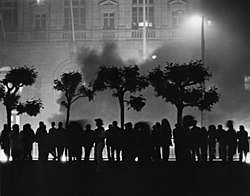
In November 1977 Harvey Milk was elected as the first openly gay politician in the city of San Francisco; he became a member of the San Francisco Board of Supervisors.[35] The Harvey Milk LGBT Democratic Club was founded as the San Francisco Gay Democratic Club in 1976 and received its current name in 1978 in honor of Harvey Milk after he was assassinated.[36] This club was a more progressive offshoot of the Alice B. Toklas Democratic Club, founded in San Francisco in 1971, the first gay Democratic club of the United States. Harry Britt was president of the club when Milk was assassinated and was appointed by the Mayor Feinstein to succeed Milk as supervisor. Britt went on to be the second openly gay elected official in San Francisco, as well as the first openly gay official to become the President of the Board of Supervisors, writing and passing domestic partnership legislation. He successfully passed rent control ordinances, was the highest elected gay official in the city during the onset of the AIDS epidemic, and later became a Vice Chair of Democratic Socialists of America.
Anne Kronenberg, who was openly lesbian, was Milk's campaign manager during his San Francisco Board of Supervisors campaign, and later worked as his aide while he held that office.[37] In 1978, lesbian Sally Miller Gearhart fought alongside Milk to defeat Proposition 6 (also known as the "Briggs Initiative" because it was sponsored by John Briggs), which would have banned gays and lesbians from teaching in public schools in California.[38] Milk was murdered on November 27, 1978 in the Moscone–Milk assassinations.[39] Riots broke out after the perpetrator, Dan White, received a manslaughter conviction, and was sentenced to seven years in prison.[35]
Gilbert Baker raised the first LGBT Pride flag at San Francisco Pride on June 25, 1978.
The Sisters of Perpetual Indulgence started in the Castro District in 1979, and eventually became nationwide.
1980s and 1990s - the AIDS crisis and response
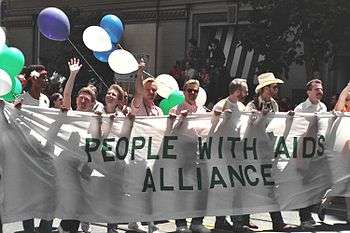
The San Francisco gay community was devastated by the AIDS epidemic following the discovery of the HIV virus in 1981.[40]
In the early 1980s,[41] AIDS began affecting the male LGBT population of San Francisco, with the disease continuing to have a fatal effect through the 1990s. 15,548 people in San Francisco had died due to AIDS prior to the introduction of drugs that treated AIDS,[42] and a total of almost 20,000 people died within 15 years of the start of the AIDS crisis. The victims had obituaries in San Francisco-area LGBT newspapers.[41] Randy Shilts, who himself later died of AIDS, was one of the foremost reporters of the AIDS epidemic.[43] He was hired as a national correspondent by the San Francisco Chronicle in 1981, becoming the first openly gay reporter with a gay "beat" in the American mainstream press.[44] In 1984, bisexual activist David Lourea finally persuaded the San Francisco Department of Public Health to recognize bisexual men in their official AIDS statistics (the weekly “New AIDS cases and mortality statistics” report), after two years of campaigning.[23] Health departments throughout the United States began to recognize bisexual men because of this, whereas before they had mostly only recognized gay men.[23] The documentary "We Were Here" covers the 1980s-1990s AIDS crisis in San Francisco. Made by David Weissman, the film opened in Los Angeles and received a screening at the Castro Theatre.[42]
The term LGB referring to Lesbian, Gay and Bisexual first began to be used in the mid-to-late 1980s to more clearly indicate the inclusion of bisexuals.[45]
The Gay Games were held in San Francisco in 1982 and 1986.
In 1984, the magazine On Our Backs begins publication in San Francisco, featuring lesbian erotica by lesbians.
Bear culture began to be popularized among gay men with the publication of Bear Magazine in San Francisco in 1987.
After 2000 - same-sex marriage and Trans awareness
The first decade of the new century saw a new awareness of transgender identity in San Francisco, with the establishment of the first Trans pride march in 2004[46] and heralded several important legal events in the movement towards Same-sex marriage in California, sparked by San Francisco mayor Gavin Newsom's move in 2004 to permit city hall to grant marriage licenses to same-sex couples.[47]
Del Martin and Phyllis Lyon became the first same-sex couple to be legally married in the United States in 2004,[47][48] However, all same-sex marriages done in 2004 in California were annulled in 2008 by California Prop 8[49] overturning a California Supreme Court decision in May 2008 that granted same-sex couples in California the right to marry. Same-sex marriages were halted until 2013 when the U.S. Supreme Court made them legal again in Hollingsworth v. Perry.
In 2004 the San Francisco Trans March was first held. It has been held annually since; it is San Francisco's largest transgender Pride event and one of the largest trans events in the entire world.[46]
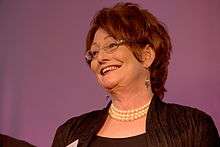
In 2007 Theresa Sparks was elected president of the San Francisco Police Commission by a single vote, making her the first openly transgender person ever to be elected president of any San Francisco commission, as well as San Francisco's highest ranking openly transgender official.[50][51][52]
In 2011, San Francisco’s Human Rights Commission released a report on bisexual visibility, titled "Bisexual Invisibility: Impacts and Regulations"; this was the first time any governmental body released such a report.[53]
In 2013 San Francisco Board of Supervisors member David Campos started a campaign to have San Francisco International Airport renamed for Harvey Milk.[39]
Pete Kane of the SF Weekly stated in 2014 that assimilation into mainstream society, "displacement due to the explosive cost of living, and atomization in the face of handheld sex" are all trends that have the potential to diminish the "LGBT community" and that these trends are "felt most acutely" in San Francisco.[54]
In 2016, the San Francisco Board of Supervisors passed a law, authored by Scott Wiener, barring the city from doing business with companies that have a home base in states such as North Carolina, Tennessee, and Mississippi, that forbid civil rights protections for LGBT people[55]
Organizations and Community Institutions
The Daughters of Bilitis (DOB) was founded in San Francisco in 1955 by four lesbian couples (including Del Martin and Phyllis Lyon) and was the first national lesbian political and social organization in the United States.[56]
The Mattachine Society moved its headquarters from Los Angeles to San Francisco in the 1950s.[12]
The Alice B. Toklas Memorial Democratic Club, a centrist LGBT Democratic Party organization, was founded around 1971.[57][58]
In 1975, the Gay Latino Alliance (GALA) was founded in San Francisco, spurred by an interest in creating a Latino float for the San Francisco Gay Pride Parade.[59] It was one of the first gay Latino organizations to exist in the United States and was situated in the Mission District of San Francisco.[60] The group was created in response to the lack of focus on intersectionality in the San Francisco gay community.[60] The alliance raised funds through dances and other events and donated the money to political grassroots campaigns.[60] One of its founders, Diane Felix, also co-founded various different queer organizations including Community United in Response to AIDS/SIDA (CURAS) in 1981 and Proyecto ContraSIDA por Vida in 1993.[61]
Proyecto ContraSIDA por Vida is a community based, grass roots HIV prevention organization in the Mission district. Notable participants and employees within the organization includes Adela Vazquez, Proyecto's first trans Latina outreach coordinator.
In 1983, BiPOL, the first and oldest bisexual political organization, was founded in San Francisco by bisexual activists Autumn Courtney, Lani Ka'ahumanu, Arlene Krantz, David Lourea, Bill Mack, Alan Rockway, and Maggi Rubenstein.[23] In 1984, BiPOL sponsored the first bisexual rights rally, outside the Democratic National Convention in San Francisco.[23] The rally featured nine speakers from civil rights groups allied with the bisexual movement.[23]
In 1987, the Bay Area Bisexual Network, the oldest and largest bisexual group in the San Francisco Bay Area, was founded by Lani Ka'ahumanu, Ann Justi and Maggi Rubenstein.[62]
The oldest national bisexuality organization in the United States, BiNet USA, was founded in 1990.[23] It was originally called the North American Multicultural Bisexual Network (NAMBN), and had its first meeting at the first National Bisexual Conference in America.[63][63][64] This first conference was held in San Francisco, and sponsored by BiPOL.[23] Over 450 people attended from 20 states and 5 countries, and the mayor of San Francisco sent a proclamation "commending the bisexual rights community for its leadership in the cause of social justice," and declaring June 23, 1990 Bisexual Pride Day.[23]
From the 1970s to the 1980s, Asian American LGBT community began their movement, establishing a number of Asian American gay and lesbian organizations in San Francisco. Gay Asian Pacific Alliance is one of the organizations that led the movements for queer Asian Americans to go against racism and sexism. In the following activities, they ran the HIV program for queer people, especially queer people of color.[65] In 1994, the Gay Asian Pacific Alliance and Asian Pacific Sister joined the Chinese New Year Parade, which was the first time that queer Asian American communities had attended in a publicly ethnic activity.[66]
The GLBT Historical Society, founded in 1985, maintains one of the world's largest archives of LGBT-related materials. Since 2011, it also has operated the GLBT History Museum in the Castro District.
The Golden Gate Business Association is an LGBT chamber of commerce.[58] The LGBT entrepreneurship organization StartOut is also based in the city.[67] The Bay Area Career Women is a lesbian professional development group.[58]
The San Francisco LGBT Community Center is in San Francisco. The growing LGBT population led to some publishers applying the moniker San Fagcisco to the city, while inhabitants were given the demonym San Fagciscan.[68]
Demographics
In the 1970s, the city's gay male population rose from 30,000 at the beginning of the decade to 100,000 in a city of 660,000 at the end of it.[69]
In 1993 Stephen O. Murray, in "Components of Gay Community in San Francisco," wrote that most LGBT residents of San Francisco had originated from other cities and had "come out" in other cities.[70] A 2015 Gallup poll found that 6.2% of San Francisco-Oakland-Hayward inhabitants identified as LGBT, the highest of any metropolitan area in the United States.[71] In the city of San Francisco itself, a 2006 survey found that 15.4% of its inhabitants identified as LGBT. In U.S. Congressional District 8, which consists of San Franciscans of voting age, 16.6% of adults identify as LGBT.[72]
According to a 2013 survey, 29% of the homeless residents of San Francisco identify as LGBT.[73]
Neighborhoods
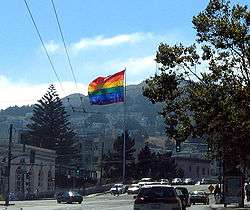
In the 1920s and 1930s the most prominent LGBT area was North Beach.[8] Polk Gulch was a popular gay neighborhood from the 1950s to the 1980s, hosting the original annual Halloween street fair which later moved to the Castro.[74] Folsom Street was the home of the first leather bars, and still hosts the annual Folsom Street Fair. In 1977 a large portion of the LGBT community was centered in the upper Market Street and Haight-Ashbury area.[35]
The Castro area of San Francisco is most well known as a gay neighborhood. This began in the 1960s and 1970s as LGBT people began moving to the community.[27] It was where Harvey Milk had his camera shop and did much of his organizing in the 1970s. The neighborhood now features permanent rainbow Pride flags, an LGBT History Museum, and a Walk of Fame with the names of notable LGBT people inscribed on the sidewalk.[75] While The Castro retained its identity, in 2014 Spencer Michels of PBS Newshour stated that The Castro became "a little more heterosexual, a slightly upscale shopping street".[41]
The Mission has long been a neighborhood with a strong queer Latino/a presence, and was home to the first Latino gay bar in San Francisco, Esta Noche, along with other gay Latino bars like La India Bonita, and El Rio.[76][77] The Mission also was the home to Proyecto ContraSIDA por Vida, a Latino/a HIV Prevention organization.[76] Lesbians, Latina and non-Latina, were particularly drawn to this neighborhood in the 1980s; it has hosted several lesbian bars, a Women's Center, coffeehouses, a bookstore, and a woman-only bathhouse.[78]
Chinatown in San Francisco is also a place closely related to LGBT culture, where its history about sexuality began with the development of sexual industry in the mid of 19 century.[79] In the mid of 20 century, as the nightclub and gay bar increasing in Chinatown, Chinatown became the most famous spot for sex tourism, attracting LGBT clients from all over the world.[80] In 1994, Gay Asian Pacific Asian and Asian Pacific Sister initially joined the Chinese New Year Parade in Chinatown, which was first time that Chinese American society had accepted Asian American LGBT organization publicly.[65]
Culture and recreation
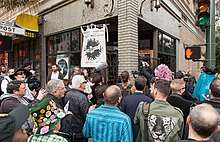
Gay bars and lesbian bars became LGBT community centers and areas where LGBT residents had public visibility.[81] Michael Stabile of Out stated that the first "notorious" gay bar was The Dash, which opened in 1908.[6] The number of San Francisco gay bars increased in the 1960s.[17] In 1973, there were 118 gay bars listed in the San Francisco Gay Yellow Pages, in 2011, there were 33.[82] The first gay bar to have clear windows was Twin Peaks Tavern, which removed its blacked-out windows in 1972.[6] The first gay Latino bar was Esta Noche, in 1979. [83] In 2014 Pete Kane stated that as same-sex rights and culture became mainstream, many gay bars in the city had closed due to gentrification[83][84] or became "post-gay".[54]
In the 1970s, softball games became a popular form of recreation for gay men and lesbians, with bar-sponsored teams competing against each other, as well as against the San Francisco police.[85]
The National Queer Arts Festival and Frameline, which is the largest and oldest LGBT film festival, are held in San Francisco.[58] Harvey Milk had founded the Castro Street Fair.[27] Other events include San Francisco Pride, the Folsom Street Fair, and Pink Saturday.
The San Francisco Gay Men's Chorus is based in the city.
The GLBT Historical Society Museum is in the Castro District.
Media
The LGBT-centric area newspapers are the Bay Area Reporter, San Francisco Bay Times,[58] and San Francisco Sentinel. Lesbian-centric magazines published in the city are Curve and Girlfriends.[58]
The growing LGBT population led to some publishers applying the moniker San Fagcisco to the city, while inhabitants were given the demonym San Fagciscan.[68]
Politics
San Francisco has open LGBT identity participation in its political system. In 2012 William Harless of PBS Newshour stated that "the gay political scene in San Francisco still an exception".[86]
The Alice B. Toklas Memorial Democratic Club is a centrist LGBT Democratic Party organization.[58] This club was founded around 1971.[57] The Harvey Milk LGBT Democratic Club is strongly left-leaning.[58] The Milk club was founded as the San Francisco Gay Democratic Club in 1976 and received its current name in 1978.[36] Both of the Democrat groups raise money during the Alice Pride breakfasts, held each June and attended by the Mayor of San Francisco and other area politicians. In 2012 members of the Barack Obama reelection campaign attended the breakfast.[86] Lynn Rapoport of the San Francisco Bay Guardian stated that in San Francisco there are "possibly even some Log Cabin Republicans."[58]
Proposition 8
The political participation for and against California Proposition 8, which sought to outlaw gay marriage, depended on race, age, level of education, and religious affiliation; there were high income neighborhoods that voted for the proposition and high income neighborhoods that voted against the proposition. More strongly religious persons were more likely to vote in favor of the proposition. Whites had a lower likelihood of being pro-Proposition 8 while blacks and Asians voted more strongly in favor of the proposition. People with university degrees voted mostly against the proposition while those who only had a high school diploma voted mostly for the proposition. The 18-29 age group voted strongly against Proposition 8 and the 60 and older age group voted strongly for it.[87] Chinese American Voter Education Committee (CAVEC; Chinese: 華裔選民教育委員會; pinyin: Huáyì Xuǎnmín Jiàoyùwěiyuánhuì) director David Lee (李志威; Lǐ Zhìwēi[88][89]) stated that immigrants who had been in San Francisco for longer than ten years largely voted against the proposition while those who had been in the city for fewer than 10 years largely voted for it.[90]
In 2008, out of the 580 precincts in San Francisco, all but 54 voted against Proposition 8. Neighborhoods voting strongly against Proposition 8 included Laurel Heights, Marina, and Mission Bay. The Mission District precinct around the 24th Street BART Station had about a 20% vote in favor of Proposition 8. About 24% of those in Sea Cliff voted for Proposition 8, and the percentage of those in St. Francis Wood voting in favor of the proposition was 35%.[87] In The Castro 3% of voters had voted in favor of Proposition 8.[90]
Areas voting over 50% in favor of Proposition 8 included portions of Bayview-Hunters Point, the Excelsior, communities around Lake Merced, and Visitacion Valley.[87] Some residents of Visitacion Valley stated that they did not want their children to learn about gay marriage in school; they mistakenly believed that the measure would ban children from learning about gay marriage at school. Other Visitacion Valley residents cited their religious beliefs.[90] Chinatown was among the areas most heavily voting for Proposition 8;[87] David Lee stated that Yes on 8 caused many Chinese-speaking voters to vote for the proposition by taking out advertisements in area Chinese newspapers.[90] The areas with the highest percentages of for votes were in portions of Chinatown and Downtown, which were 65% in favor. The parts of Downtown included the condominiums of the Four Seasons Hotel, San Francisco and the St. Regis Museum Tower as well as other city blocks around Bloomingdale's. Political consultant David Latterman stated that the residents in that area had recently moved into San Francisco and were less connected to the city compared to those in other wealthy areas.[87]
In fiction
The series' Tales of the City and Looking depicts LGBT culture in San Francisco.
The novel Valencia by Michelle Tea explores the lesbian culture of the 1990s Mission District.
The novel A Horse Named Sorrow by Trebor Healey is set in San Francisco in the 1980s and 90's.
The Emma Victor series of mystery novels by Mary Wings is about a San Francisco lesbian private investigator.
In pixar's 2015 film Inside Out, the LGBT culture is referenced by Anger by mentioning that he saw someone who resembles a bear.
Notable people
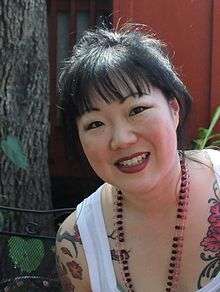
- Tom Ammiano, activist and politician
- Harry Britt (activist and city supervisor)
- David Campos (gay member of the San Francisco Board of Supervisors)
- Margaret Cho, (bisexual comedian and native San Franciscan.)
- Lea Delaria, comedian, actress and musician whose career started in San Francisco
- Cleve Jones (gay activist)
- Bill Kraus (gay rights and AIDS activist)
- Alec Mapa (actor)
- Del Martin and Phyllis Lyon (lesbian activists)
- Harvey Milk (gay former member of the San Francisco Board of Supervisors)
- Armistead Maupin, author of Tales of the City
- Jose Sarria (entertainer and activist)
- Bradford Shellhammer, (entreprenure, co-founder Fab, Bezar and founding editor of Queerty)
- Randy Shilts, (writer and reporter for the San Francisco Chronicle and The Advocate)
- Theresa Sparks (transgender Executive Director of the San Francisco Human Rights Commission)
- Rikki Streicher (businesswoman, activist, tavern owner, Gay softball promoter, co-founder of the Gay Games)
- Sylvester, singer who began his career in San Francisco
- Michelle Tea, (author of San Francisco lesbian novel Valencia)
- Carol Queen (bisexual author, editor, sociologist and sexologist)
- Adela Vazquez (trans Cuban activist, HIV case manager, Latino AIDS Education and Prevention Program Coordinator)
- Bianca Von Krieg (LGBT activist, television personality, actress, comedienne)
References
- Boyd, Nan Almilla. Wide-Open Town: A History of Queer San Francisco to 1965. University of California Press, May 23, 2003. ISBN 0520938747, 9780520938748.
- Lipsky, William. Gay and Lesbian San Francisco. Arcadia Publishing, 2006. ISBN 0738531383, 978-0738531380.
- Murray, Stephen O. "Components of Gay Community in San Francisco" (Chapter 4). In: Herdt, Gilbert H. Gay Culture in America: Essays from the Field. Beacon Press, January 1, 1993. ISBN 0807079154, 9780807079157. Start page: 107.
- Ormsbee, Todd J. The Meaning of Gay: Interaction, Publicity, and Community among Homosexual Men in 1960s San Francisco. Lexington Books, July 10, 2012. ISBN 0739144715, 9780739144718.
- Sheiner, Marcy. "The Foundations of the Bisexual Community in San Francisco: An Interview with Dr. Maggi Rubenstein", in the anthology Bi Any Other Name: Bisexual People Speak Out, edited by Lorraine Hutchins and Lani Ka'ahumanu, Alyson Publications, 1991. ISBN 1-55583-174-5, 978-1555831745.
Notes
- ↑ Kompes, Gregory A. 50 Fabulous Gay-Friendly Places to Live. Career Press. ISBN 1564148270, 9781564148278. p. 66.
- ↑ Haber, Matt. "Technology’s Rainbow Connection." The New York Times. July 20, 2014. Retrieved on September 6, 2014. Print: New York Edition, p. ST1, "Technology’s Rainbow Connection"
- 1 2 3 Boyd, Nan Alamilla (2003). Wide-open town: A history of queer San Francisco to 1965. Univ of California Press. p. 2.
- 1 2 3 Sears, Clare (2014). Arresting Dress: Cross-dressing, Law, and Fascination in Nineteenth-century San Francisco. Duke University Press. p. 24.
- ↑ "San Francisco Call". "Hugged by a Boy". August 3, 1894. Retrieved April 21, 2016.
- 1 2 3 4 "12 Bars That Made San Francisco Gay, In Chronological Order Archived 2016-01-26 at the Wayback Machine." (Archive). Out. September 20, 2013. Retrieved on September 6, 2014.
- ↑ https://thebolditalic.com/gay-and-not-so-gay-moments-in-san-francisco-history-the-bold-italic-san-francisco-f92c3a7bfb92#.lw0c3sum8
- 1 2 3 Sibalis, Michael. "Urban Space and Homosexuality: The Example of the Marais, Paris' 'Gay Ghetto'" (Wilfrid Laurier University). Urban Studies. August 2004 vol. 41 no. 9 p. 1739-1758. DOI 10.1080/0042098042000243138. CITED: p. 1739.
- ↑ Nan Alamilla Boyd, Wide-Open Town: A History of Queer San Francisco to 1965 University of California Press, 2003
- ↑ http://dangerousminds.net/comments/wigs_waxing_and_song_meet_the_drag_pioneers_of_the_1920s_pansy_craze
- ↑ Bérubé, Allan. Coming out under fire : the history of gay men and women in World War Two. n.p.: New York : Free Press, c1990
- 1 2 Ormsbee, p. 306.
- 1 2 Carlsson, Chris (1995). "The Castro: The Rise of a Gay Community". Found SF. Retrieved 2016-06-11.
- ↑ Boyd p. 56
- ↑ Gary Kamiya, "Boisterous Dive's Saga Is the Story of SF's Seamier Side", San Francisco Chronicle (October 31, 2014)
- ↑ Bullough, Vern L. (2002). Before Stonewall: d Activists for Gay and Lesbian Rights in Historical Context. New York: Haworth Press. p. 157. ISBN 1-56023-193-9.
- 1 2 3 Ormsbee, p. 307.
- ↑ Society for Individual Rights Collection
- ↑ Bill Brent, "Society for Individual Rights", Black Sheets magazine, 1998 Retrieved December 31, 2016
- ↑ http://www.foundsf.org/index.php?title=1966_Vanguard_Sweep
- ↑ http://www.glbthistory.org/Vanguard/images%20vanguard/vanguard-lowres.pdf
- ↑ "Social sciences - San Francisco". glbtq. Archived from the original on 2015-07-05. Retrieved 2012-05-15.
- 1 2 3 4 5 6 7 8 9 10 11 12 "TIMELINE: THE BISEXUAL HEALTH MOVEMENT IN THE US". BiNetUSA.
- ↑ "The San Francisco Chronicle", June 29, 1970
- ↑ "As of early 1970, Neil Briggs became the vice-chairman of the LGBTQ Association", CanPress, February 28, 1970.
- ↑ Samuel Walker (2013-08-26). "First Gay Liberation Day (Gay Pride March) in New York City". Today in Civil Liberties History. Archived from the original on 2016-04-10. Retrieved 2016-06-11.
- 1 2 3 "San Francisco : The Castro" (Archive). San Francisco Chronicle. Retrieved on September 6, 2014.
- ↑ Holleran, Andrew. "The Petrification of Clonestyle". Christopher Street. 6 (69). pp. 14–17.
- ↑ Adrienne Skye Robert, SF Moma Open Space, "We thought the world we built would be forever: An Interview with Lenn Keller", June 16, 2012
- ↑ Uncle Donald's Castro Street Retrieved December 23, 2016
- ↑ William Lipsky, Gay and Lesbian San Francisco, Arcadia Publishing, 2006
- ↑ Joshua Gamson, The Fabulous Sylvester: The Legend, the Music, the Seventies in San Francisco, Henry Holt and Company, Jul 30, 2013
- ↑ https://www.nytimes.com/2010/05/30/movies/homevideo/30kehr.html
- ↑ https://books.google.com/books?id=Eg_4Eus1sE0C&pg=PA327
- 1 2 3 "Harvey Milk." The New York Times. Retrieved on September 7, 2014.
- 1 2 "About Harvey Milk LGBT Democratic Club Archived 2014-09-07 at the Wayback Machine." (Archive). Harvey Milk LGBT Democratic Club. Retrieved on September 7, 2014.
- ↑ The Lesbian in "Milk": Alison Pill as Anne Kronenberg | Movie Reviews, Celebrity Interviews & Film News About & For Gay, Lesbian & Bisexual Women Archived 2009-03-02 at the Wayback Machine.. AfterEllen.com (2008-11-24). Retrieved on 2010-11-30.
- ↑ The Resurrection of Harvey Milk | People Archived 2010-01-03 at the Wayback Machine.. The Advocate. Retrieved on 2010-11-30.
- 1 2 Hetter, Katia. "Will San Francisco name airport after slain gay icon Harvey Milk?" (Archive). CNN. January 15, 2013. Retrieved on September 2, 2014.
- ↑ "The History of the Castro". KQED. KQED. 2009. Archived from the original on 2016-01-15. Retrieved 2016-06-11.
- 1 2 3 "‘We Were Here’ Revisits San Francisco’s AIDS Epidemic of Early ’80s" (Archive). PBS Newshour. June 14, 2012. Retrieved on September 7, 2014.
- 1 2 "'We Were Here' documents AIDS crisis in the 1980s." Los Angeles Times. September 16, 2011. Retrieved on September 7, 2014.
- ↑ Weiss, Mike (February 17, 2004). "Randy Shilts was gutsy, brash and unforgettable. He died 10 years ago, fighting for the rights of gays in American society". San Francisco Chronicle. Retrieved 6 January 2013.
- ↑ Randy Shilts at Queer Theory Archived 2012-10-06 at the Wayback Machine. Retrieved on 2007-01-03
- ↑ Acronyms, Initialisms & Abbreviations Dictionary, Volume 1, Part 1. Gale Research Co., 1985, ISBN 978-0-8103-0683-7. Factsheet five, Issues 32–36, Mike Gunderloy, 1989
- 1 2 "About the San Francisco Trans March | San Francisco Trans March". Transmarch.org. 2004-06-25. Retrieved 2012-11-06.
- 1 2 "Lesbian couple wedded at SF City Hall Women had been together for five decades". The San Francisco Chronicle. February 13, 2004. Archived from the original on May 21, 2008.
- ↑ Jonathan Darman (2009-01-16). "SF Mayor Gavin Newsom Risks Career on Gay Marriage - Newsweek and The Daily Beast". Newsweek.com. Retrieved 2012-11-06.
- ↑ "Prop 8 proponents seek to nullify same-sex marriages". CNN. 2008-12-19.
- ↑ Selna, Robert; Sward, Susan; Vega, Cecilia M. Renne Quits Police Commission, San Francisco Chronicle (May 11, 2007), pp. B-9. Retrieved on May 13, 2007.
- ↑ SF Police Commission Makes History, KCBS (May 10, 2007). Retrieved on May 13, 2007. Archived May 29, 2007, at the Wayback Machine.
- ↑ McMillan, Dennis. Sparks Is First Trans Person to Lead Major Commission San Francisco Bay Times (May 17, 2007). Retrieved on October 15, 2007.
- ↑ Diane Anderson-Minshall (September 23, 2011). "The Biggest Bisexual News Stories of 2011".
- 1 2 Kane, Pete. "Queer Flight: Does the Success of Gay Rights Mean the End of Gay Culture?" SF Weekly. Wednesday June 4, 2014. p. 1 Archived 2016-02-14 at the Wayback Machine. (Archive). Retrieved on September 7, 2014.
- ↑
- ↑ >> social sciences >> Daughters of Bilitis Archived 2011-06-29 at the Wayback Machine.. glbtq (2005-10-20). Retrieved on 2010-11-30.
- 1 2 "About Archived 2014-09-07 at the Wayback Machine." (Archive). Alice B. Toklas Memorial Democratic Club. Retrieved on September 7, 2014.
- 1 2 3 4 5 6 7 8 9 Rapoport, Lynn. "Is San Francisco still a gay mecca?" (Archive). San Francisco Bay Guardian. Retrieved on September 6, 2014.
- ↑ Ramirez, Horacio (2003). ""That's My Place!": Negotiating Racial, Sexual, and Gender Politics in San Francisco's Gay Latino Alliance, 1975-1983". Journal of the History of Sexuality. 12 (2): 224–258.
- 1 2 3 Ramirez, Roque; N, Horacio (2003-01-01). ""That's My Place!": Negotiating Racial, Sexual, and Gender Politics in San Francisco's Gay Latino Alliance, 1975-1983". Journal of the History of Sexuality. 12 (2): 224–258. doi:10.1353/sex.2003.0078. ISSN 1535-3605.
- ↑ Hidalgo de la Riva, Osa. Chicana Spectators and Mediamakers. Spectator 26:1 (Spring 2006): 21-26
- ↑ "Bisexual network celebrates 25 years". www.ebar.com. 2012. Retrieved January 7, 2013.
- 1 2 "All About BiNet USA including the Fine Print". BiNet USA. Retrieved 2012-11-06.
- ↑ Summers, Claude J. (2009-10-20). "BiNet USA". glbtq: An Encyclopedia of Gay, Lesbian, Bisexual, Transgender, and Queer Culture. glbtq, Inc. Archived from the original on 2014-02-20.
- 1 2 Yeh, Chiou-Ling (2010). Making an American Festival: Chinese New Year in San Francisco's Chinatown. University of California Press. p. 174. ISBN 9780520253513.
- ↑ Lavilla, S. (1998, Jul 09). A growing show of pride: Record asian american presence at parade reflects a growing acceptance. Asianweek Retrieved from http://search.proquest.com/docview/367563813
- ↑ Allison, Scott. "Gay in Silicon Valley. A Founder's Perspective." Forbes. August 25, 2012. Retrieved on September 6, 2014.
- 1 2 Professing in the Contact Zone- Page 124, Janice M. Wolff - 2002
- ↑ Michelle Cochrane, When AIDS Began: San Francisco and the Making of an Epidemic Routledge, Aug 2, 2004, p. 22
- ↑ Murray, p. 108.
- ↑ http://www.gallup.com/poll/182051/san-francisco-metro-area-ranks-highest-lgbt-percentage.aspx
- ↑ http://williamsinstitute.law.ucla.edu/wp-content/uploads/Gates-Same-Sex-Couples-GLB-Pop-ACS-Oct-2006.pdf
- ↑ https://thinkprogress.org/how-san-francisco-is-forcing-its-gay-population-onto-the-streets-9cd9882118d5#.16fx1ay2d
- ↑ https://thebolditalic.com/tears-for-queers-the-bold-italic-san-francisco-a695c0756f28#.qtmq2qyfu
- ↑ http://www.ebar.com/news/article.php?sec=news&article=69992
- 1 2 Rodríguez, Juana María. Queer Latinidad: Identity Practices, Discursive Spaces. New York: NYU Press, 2003.
- ↑ Ramirez, Roque, and Horacio N. “‘That’s My Place!’: Negotiating Racial, Sexual, and Gender Politics in San Francisco’s Gay Latino Alliance, 1975-1983.” Journal of the History of Sexuality 12, no. 2 (2003): 224–58. doi:10.1353/sex.2003.0078.
- ↑ [http://www.sfweekly.com/sanfrancisco/pride-of-place-as-the-nations-gay-districts-grow-more-affluent-lesbians-are-migrating-to-the-burbs/Content?oid=2950085 Rachel Swan, San Francisco Weekly, Pride of Place: As the Nation's Gay Districts Grow More Affluent, Lesbians Are Migrating to the 'Burbs Jun 25 2014
- ↑ Tong, Benson (1994). Unsubmissive women : Chinese prostitutes in nineteenth-century San Francisco. Norman : University of Oklahoma Press. ISBN 0806126531.
- ↑ LESBIAN SPACE, LESBIAN TERRITORY: San Francisco’s North Beach District, 1933–1954. Boyd, Nan Alamilla. Wide-Open Town. pp 79. Berkeley, US: University of California Press, 2003.
- ↑ Boyd, p. 61.
- ↑ http://www.slate.com/articles/life/the_gay_bar/2011/06/the_gay_bar.html
- 1 2 Press, Berkeley Electronic. """'Mira, Yo Soy Boricua y Estoy Aquí': Rafa Negrón's Pan Dulce and the Queer Sonic Latinaje of San Francisco"" by Horacio N Roque Ramirez". works.bepress.com. Retrieved 2016-04-07.
- ↑ Vargas, Deborah R. (2014-01-01). "Ruminations on Lo Sucio as a Latino Queer Analytic". American Quarterly. 66 (3): 715–726. doi:10.1353/aq.2014.0046. ISSN 1080-6490.
- ↑ KATIE BAKER, Grantland, Softball and the Gay Empowerment Movement, JULY 25, 2014,
- 1 2 Harless, William. "How Important is the Gay and Lesbian Vote for the Upcoming Election?" (Archive). PBS Newshour. July 16, 2012. Retrieved on September 7, 2014.
- 1 2 3 4 5 Knight, Heather. "Some areas of S.F. voted to ban same-sex marriage." San Francisco Chronicle. Friday November 14, 2008. p. 1. Retrieved on September 7, 2014.
- ↑ "李志威於選前兩周推出中文電視廣告,呼籲華裔選民投票,目前華裔申請郵寄選票的數字已在一周內增倍。(取材自華裔選民教育委員會影片) Archived 2015-03-08 at the Wayback Machine." (Archive). Chinese American Voter Education Committee. May 2014. Retrieved on September 7, 2014. "華裔選民教育委員會行政主任李志威[...]"
- ↑ "David Lee, executive director of the Chinese American Voters Education Committee, attributed Chiu’s primary victory to the Chinese-American absentee voter turnout being as much as 10 percentage points higher than the districtwide absentee voter turnout overall as of Friday. “David Chiu has been working on Chinese outreach and is better known in the Chinese community and he’s recognizable as one of the top Chinese-American elected officials in The City,” Lee said. “And Asian voters have demonstrated overtime a strong identity vote.” Archived 2015-03-08 at the Wayback Machine." (Archive). Chinese American Voter Education Committee. June 4, 2014. Retrieved on September 7, 2014.
- 1 2 3 4 Knight, Heather. "Some areas of S.F. voted to ban same-sex marriage." San Francisco Chronicle. Friday November 14, 2008. p. 2. Retrieved on September 7, 2014.
Further reading
- Fritscher, Jack. Gay San Francisco: Eyewitness Drummer : a Memoir of the Sex, Art, Salon, Pop Culture War, and Gay History of Drummer Magazine, the Titanic 1970s to 1999, Volume 1. Palm Drive Publishing, November 1, 2006. ISBN 1890834394, 9781890834395.
- Lipsky, William. Gay and Lesbian San Francisco. Arcadia Publishing, 2006. ISBN 0738531383, 978-0738531380.
- Sheiner, Marcy. "The Foundations of the Bisexual Community in San Francisco: An Interview with Dr. Maggi Rubenstein", in the anthology Bi Any Other Name: Bisexual People Speak Out, edited by Lorraine Hutchins and Lani Ka'ahumanu, Alyson Publications, 1991. ISBN 1-55583-174-5, 978-1555831745.
- Stryker, Susan and Jim Van Buskirk. Gay by the Bay: A History of Queer Culture in the San Francisco Bay Area. Chronicle Books, March 1, 1996. ISBN 0811811875, 9780811811873.
